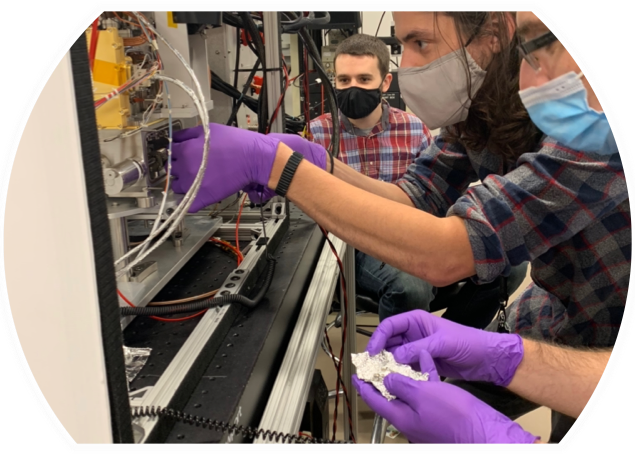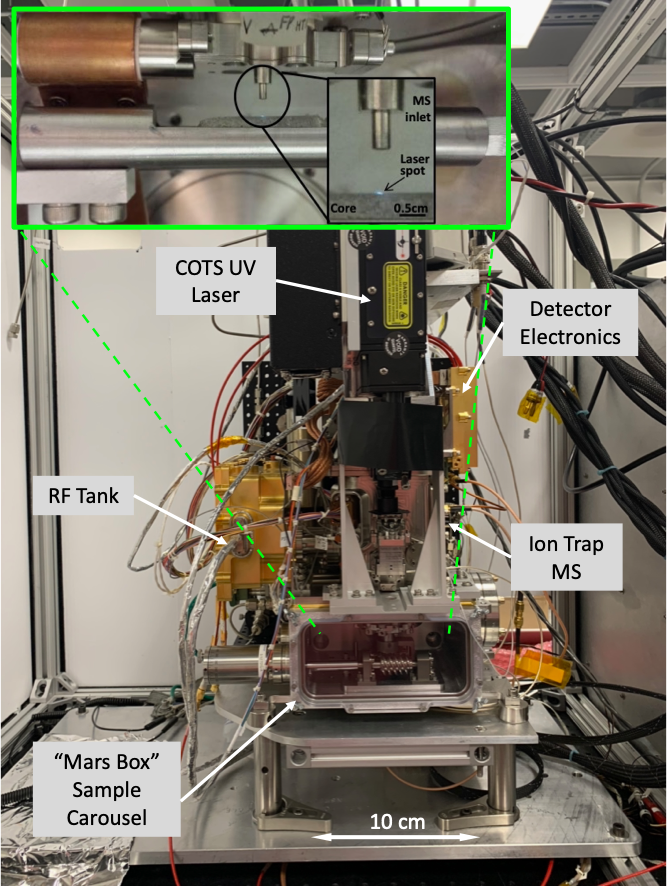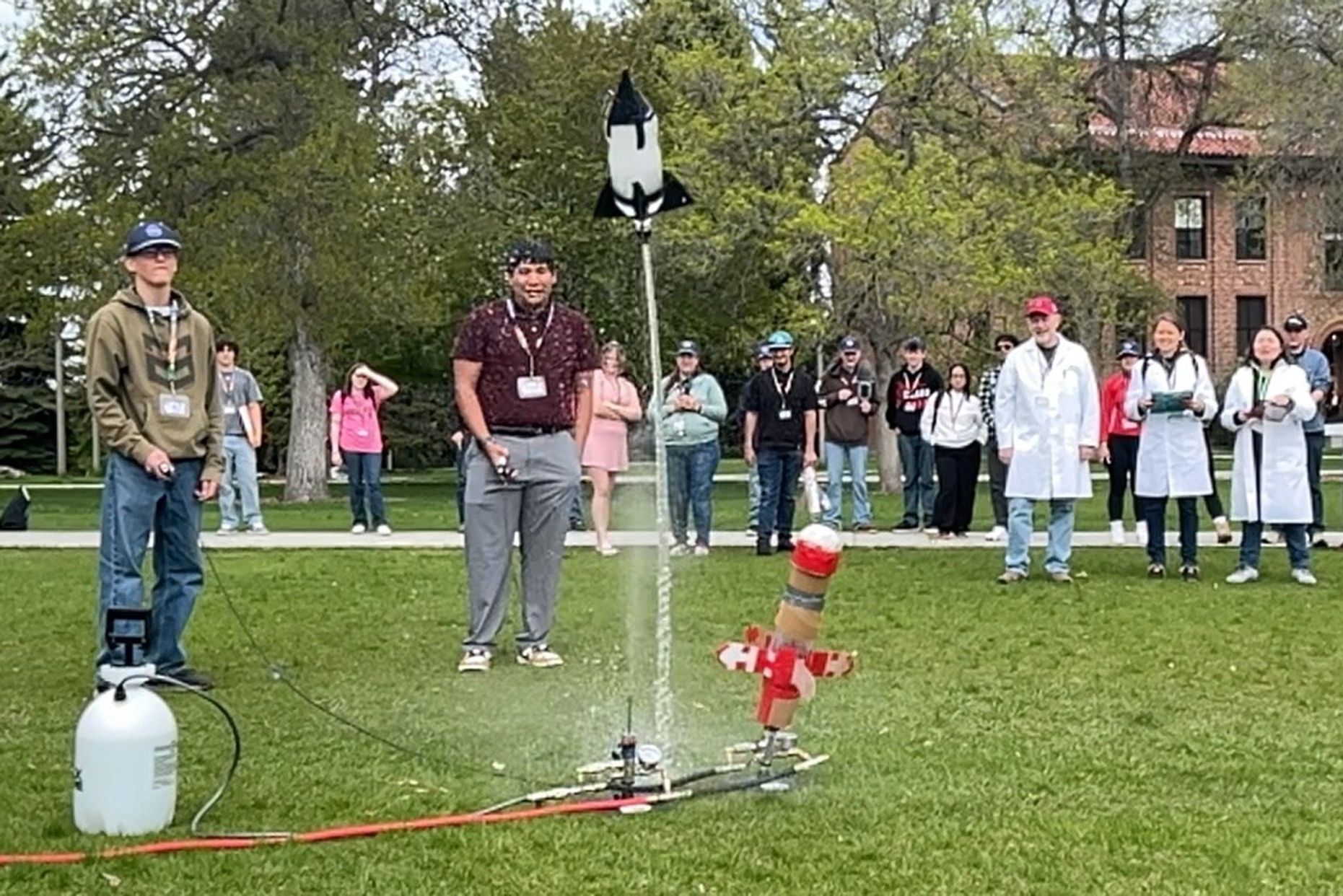PROJECT
Linear Ion Trap Mass Spectrometer (LITMS)
SNAPSHOT
To address the growing need for in situ molecular analysis of Mars samples at fine spatial scales, NASA is developing the miniature LITMS instrument, which combines a laser and gas chromatograph mass spectrometer with a precision subsampling system. LITMS executes a powerful search for biosignatures and geochemical gradients in a rock sample’s individual layers where such features are most distinct.
BACKGROUND
Mars continues to entrance and challenge us as a world at once strikingly Earth-like, and yet clearly alien upon closer investigation. Tantalizing evidence of an early water-rich era and the potential for subsurface preservation have made the prospect of detecting ancient or even modern signs of life a central focus of Mars exploration. A series of powerful orbiting and surface missions over the past few decades has greatly enriched our understanding of Mars as a complex, dynamic planet, with select regions exhibiting evidence of having been habitable in the past.
These missions have culminated most recently in the arrival of the Perseverance rover, which is both exploring for potential signatures of past life and collecting high-value samples for later analysis in Earth labs via Mars Sample Return (MSR). The MSR samples will bring unprecedented depth to our investigation of the geochemistry, habitability, and possibly the biology of Mars, enabled by the ultra-sensitive and micron-scale probes afforded by terrestrial laboratories. Along with new knowledge, MSR will also inevitably invite new questions and motivate continued future exploration, likely with a finer scientific focus.
Future robotic missions to examine potential niches for the preservation of biosignatures will undoubtedly call for more intensive study of the molecular composition of samples at fine spatial scales. Martian rock samples are heterogeneous on millimeter and submillimeter scales, reflecting the merging of various mineral phases of differing origins during rock formation or the deposition of thin sedimentary layers. Furthermore, organic compounds that may only occur in trace amounts in the bulk rock, and thus are hard to detect in the presence of high background noise, may be found at much higher concentrations in isolated phases or layers. As on Earth, such layers would be most evident in a drill core sample, where even “short” (few-cm) intact cores can record dramatic chemical variations with depth.
Instruments that perform fine (submillimeter) scale analysis of rock samples are presently deployed on the Perseverance rover. These key investigations enable in situ science as well as identify samples for return to Earth. Looking forward, the need for detailed molecular characterization at such scales, with the full analytical toolkit of a multi-source mass spectrometer, will grow. Scientists will want to distinguish potential biosignatures such as complex organic compounds or homochirality – life’s preference for using only right- or left-handed forms of certain chiral molecules. To this end, an SMD-sponsored team based at Goddard Space Flight Center has been developing the Linear Ion Trap Mass Spectrometer (LITMS) instrument for precision molecular analysis on a future Mars astrobiology lander or rover.
LITMS INSTRUMENT
LITMS is an enhanced version of the Mars Organic Molecule Analyzer (MOMA) mass spectrometer that will launch on the ExoMars rover mission in 2022. Like MOMA, LITMS incorporates both gas chromatograph mass spectrometry (GCMS) and laser desorption mass spectrometry (LDMS) modes to enable investigation of a wide range of compounds. But LITMS analyzes an expanded set of compounds with higher precision, through improvements such as the ability to detect a wider range of molecular weights and the capability to analyze negative polarity ions in addition to the positive ion spectra MOMA can analyze. LITMS also incorporates a precision sampling system that allows a rock core sample to be interrogated by both a fine grinding tool (for GCMS) and a focused laser (for LDMS), providing complementary molecular analyses from submillimeter-scale points on the core.
A conceptual schematic of LITMS as configured for a mission is shown below. The linear ion trap analyzer is contained in the mass spectrometer (MS) Housing, which is mounted to a rover/lander interface plate. The radio frequency (RF) Tank provides the oscillating voltage to the electrodes that trap and eject ions.
In the figure above, LITMS is interfaced to a robotic arm that has positioned an acquired drill core (nominally 8 mm diameter and several cm long) underneath the MS. The core is held in a PreView Bit (developed by NASA’s partners at Honeybee Robotics), which contains a slot to enable viewing and analysis of the core (that may have layers as pictured). In the depicted position, any point on the exposed core can be sampled by the pulsed ultraviolet (UV) laser, forming ions that are ingested directly through the Aperture Valve and a narrow tube into the MS. The laser focal spot is only a fraction of a mm in diameter and allows precise maps to be generated by slowly moving the core. In a second retracted position above the Precision Core Sampler, a thin grinding wheel is pressed gently on the core to generate a few milligrams of powder that falls through a funnel into a small cylindrical oven (not shown in the figure). The oven may then be sealed and heated to create gas from the powder sample for analysis by GCMS. This sequence allows the LDMS analysis, which is essentially non-destructive, to identify high-priority points on the core for GCMS analysis, providing a powerful “one-two punch” to detect trace molecules hidden in a single core layer.
With support from NASA’s Maturation of Instruments for Solar System Exploration (MatISSE) Program, the Goddard team has developed a prototype of LITMS with the same size, shape, capabilities, and control system as a flight instrument. This model, shown in the photo below, can interface both with the robotic arm and Preview Bit system (not shown) as well as a rotating sample cup carousel (as in the photo) to allow loading of powdered samples for testing and field deployment. For laboratory and field testing a small commercial off-the shelf (COTS) Ultraviolet (UV) laser is used in place of the unique flight prototype laser.
The figure inset shows a closeup image of the bottom of the ion inlet tube (with Aperture Valve) just above a Mars analog rock core (a rock sample similar to those found on Mars) held in position by the Preview Bit. Optical emission from the UV laser is visible on the core surface directly under the inlet.
During the MatISSE-sponsored project, the LITMS prototype (including MS, flight-like electronics, and precision sampler) was designed, assembled, and tested in the laboratory using a range of “standard” samples (those with known compositions designed to check instrument performance) as well as several natural Mars analogs, including some similar in composition to rocks observed on previous Mars missions. During lab testing, the team discovered that in soils containing perchlorate (an inorganic chemical found on Mars) LITMS was able to detect the specific perchlorate anion and identify its metal center (e.g., Mg or Ca) while simultaneously detecting high-molecular-weight aromatic organic compounds using LDMS. Furthermore, LITMS showed great promise for the detection of organics that could be associated with biological matter isolated in thin layers or small mineral phases.
ATACAMA FIELD CAMPAIGN
The flight-like design of LITMS allows it to be configured in a highly compact form for field testing, allowing for the analysis of organic and inorganic molecules in Earth environments under selected operational constraints to simulate those of a flight mission. These capabilities were demonstrated in a preliminary field campaign in the Atacama Desert, Chile, in March 2019 as part of the Atacama Rover Astrobiology Drilling Studies (ARADS) project, led by Dr. Brian Glass of NASA Ames Research Center and supported through the NASA Planetary Science and Technology from Analog Research (PSTAR) Program.
For the ARADS campaign, significant repackaging of the laboratory prototype was completed to provide a standalone, environmentally tolerant system. Features of the fieldable LITMS include a ruggedized, shock-mounted chassis; a highly compact implementation of the brassboard electronics modules into a “mini-crate” analog of the flight main electronics box; and a gas handling and pumping system to enable contamination-free user-mounting of samples into a chamber that simulates the martian environment for which LITMS was designed. ARADS represents one of the first deployments of a flight-like planetary mass spectrometer to a high-fidelity analog field site.

While in the Atacama, in situ analyses of samples from the surface down to 90 cm depth were performed with LITMS. These analyses showed significantly varying chemical profiles (relative quantities of inorganic and organic compounds reflected as mass spectral peak patterns) with increasing depth, which reflects the compositional changes related to layers of varying environmental processing and preservation in the ultra-arid Atacama soil. These preliminary data provide extremely useful input for short-term “tactical” decisions about further drilling and examination by LITMS and other rover instruments. The longer-term “strategic” analysis performed after the field campaign, which is ongoing in the lab at Goddard, is analogous to the process on a mission where future site selection and updated hypotheses result from in-depth processing and analysis of previously collected data.
PATH FORWARD FOR LITMS
LITMS is ready to proceed to a flight mission to Mars or elsewhere, should the opportunity arise. The team continues to analyze Atacama and other analog samples to research the relationship between the analog environment and the characterization of potentially biogenic organics. Future field campaigns to perform additional in situ science and gain field instrument experience are of high interest to the LITMS team, particularly given the deployment-ready configuration of the instrument.
In the lab, the LITMS instrument can serve as a powerful tool for examining analogs of samples that may be found at Oxia Planum by the ExoMars rover and analyzed with MOMA in 2023. While MOMA relies on its Testbed Model on Earth to exactly duplicate the behavior and performance of the flight instrument on Mars, that Testbed Model is primarily a diagnosis and verification tool and will not be used for extensive analog sample analyses to aid science interpretation during the mission.
LITMS, however, can serve not only as a performance-traceable resource for the MOMA team, but may also illuminate sample properties, such as the full variety of organics present, that may be unclear from MOMA data alone, due to the detection enhancements built into LITMS. The LITMS prototype additionally offers a platform to test new analytical protocols that could be implemented on MOMA through its built-in control software re-programmability. One example of this is the optimization of tandem mass spectrometry, or MS/MS, that enables individual organic compounds to be isolated and their internal structures studied. LITMS enables MS/MS to be tested extensively on complex samples to evaluate its potential utility on Mars.
Finally, another beneficial outcome of the LITMS effort is the design of the spectrometer on the upcoming Dragonfly mission to Saturn’s moon Titan. Currently under development, the Dragonfly Mass Spectrometer (DraMS) is a highly advanced linear ion trap-based instrument that features several of the new capabilities and lessons learned from LITMS. NASA expects DraMS to conduct a thorough analysis of the extraordinary and compelling surface composition of Titan.
PROJECT LEAD
Dr. William B. Brinckerhoff, NASA Goddard Space Flight Center
SPONSORING ORGANIZATION
PSD’s Maturation of Instruments for Solar System Exploration (MatISSE) Program, the Goddard Instrument Field Team (GIFT), and the Planetary Science and Technology from Analog Research (PSTAR) Program.






































